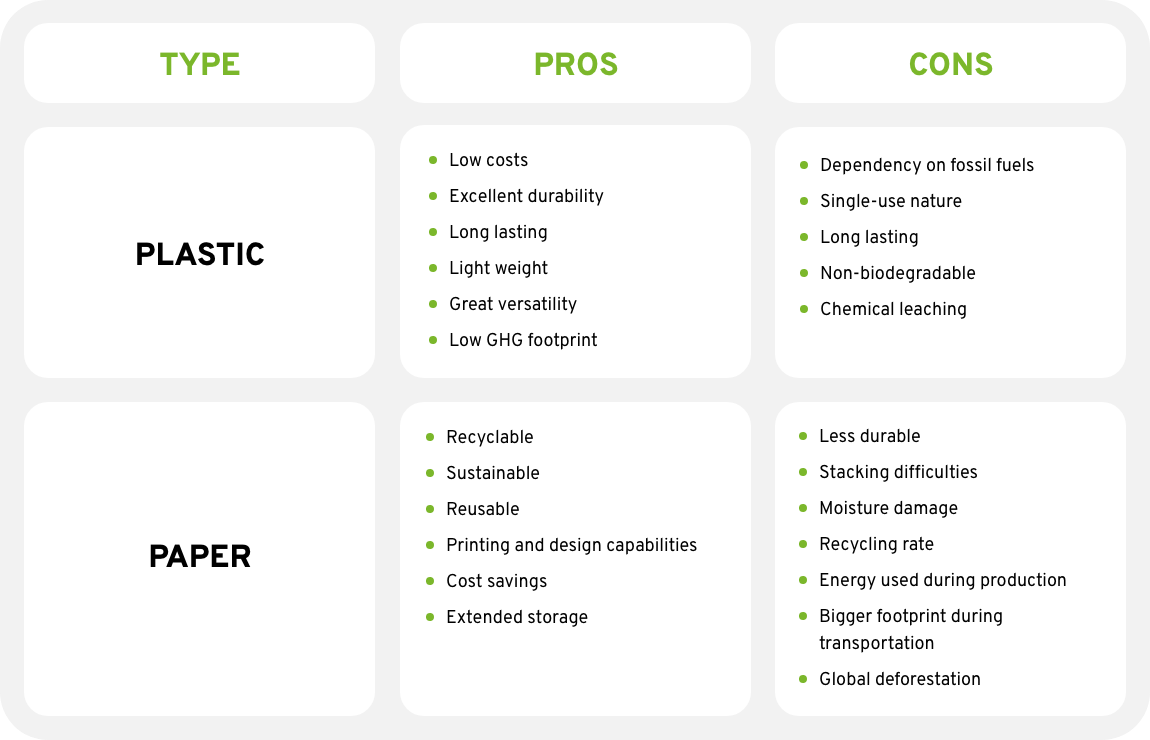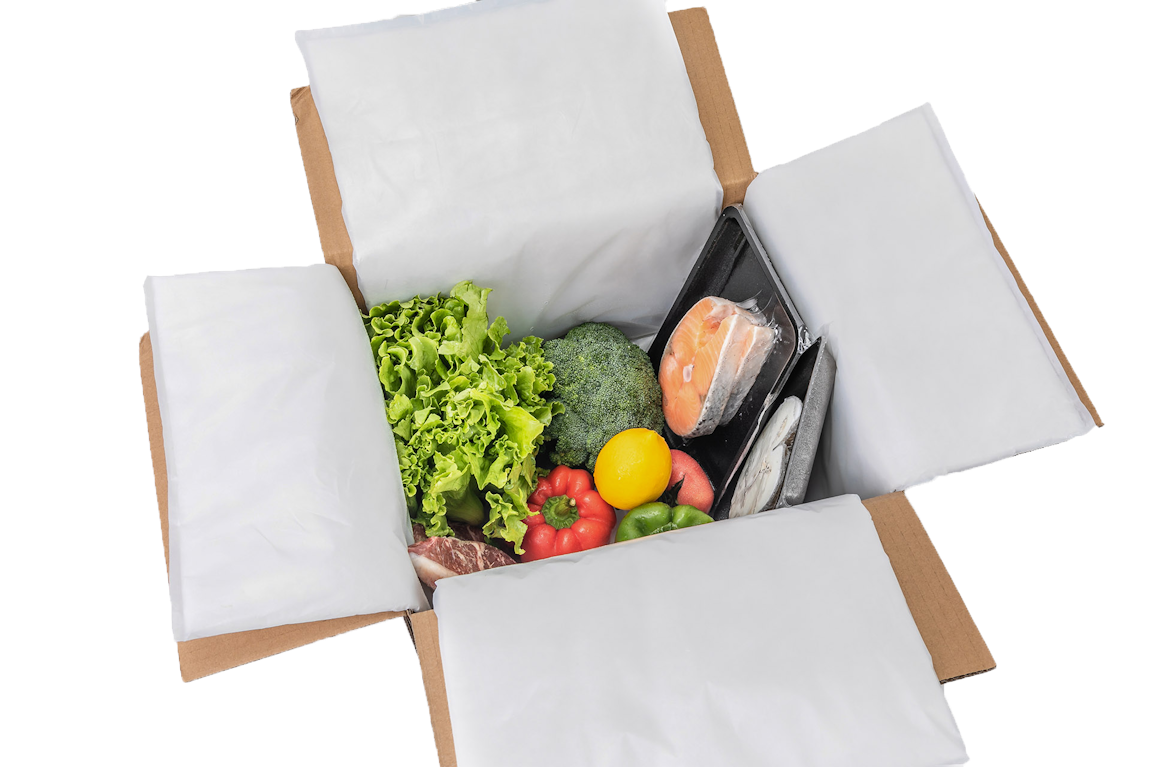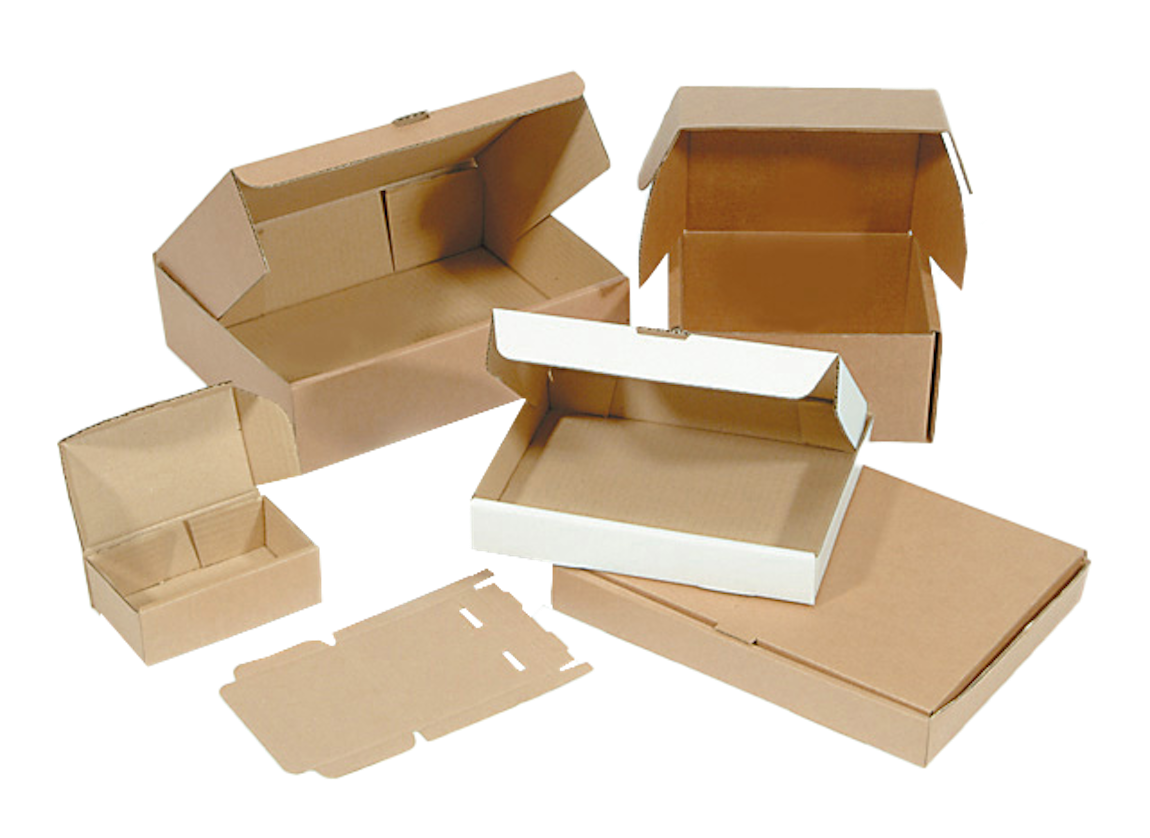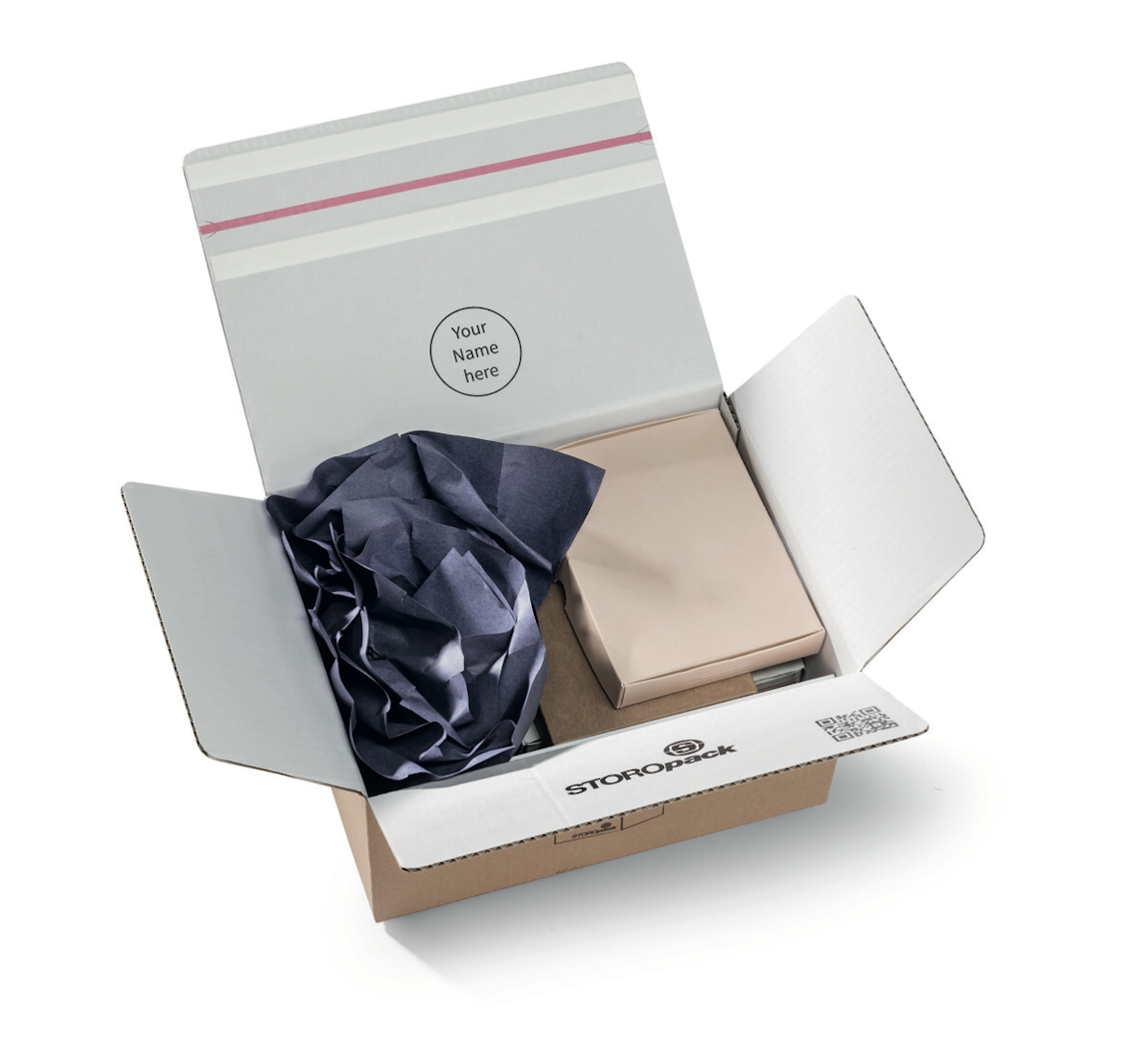Plastic vs Paper Packaging: The Pros and Cons
Many companies are switching to paper packaging instead of plastic packaging to become more sustainable, especially with the new Plastic Packaging Tax Regulations. However, switching to paper also has its environmental issues.
For example, cardboard production is water intensive, generates emissions and runs the risk of encouraging deforestation if not sourced sustainably. On top of that it is difficult to recycle if contaminated with food or other waste.
So, are paper and cardboard really more eco-friendly than plastic? Could Bioplastics be the answer to all sustainability problems? In this article, we will look at the bigger picture and explore the pros and cons for both plastic and paper.

We know you are busy, so we decided to put in a quick table with the pros and cons of both plastic and paper, so you can see the clear positives and negatives of each that are discussed further in this article.

Plastic
Plastics came into existence by accident in 1907, but it grew popular around the 1950s when high-density polyethylene was created. Plastics are made from fossil fuels which is clearly a non-renewable source. It is estimated that 4% of the world’s oil production is used as feedstock to make plastics, so this means plastic is often viewed as poor material in terms of renewability and sustainability.
However, it's not all doom and gloom with plastic. In recent times various reports from credible sources such as McKinsey have come out that plastic also brings certain benefits compared to other materials such as paper. The most sustainable approach is to look at the bigger picture, compare the pros and cons of the material and see them in the context of what situation the material is used.
The Plastic Pro’s
Although they are bad for the environment, there are a number of reasons why some may find plastics difficult to give up. These are as follows:
- Low costs: Plastic is the cheapest out of all common packaging materials.
- Excellent Durability: Plastics do not break or get damaged easily and can withstand falls or slight trauma without damage so provides great protection. Plastic packaging often does not get damaged when stacked on top of each other, making transportation of products easier.
- Long lasting: Plastic takes about a thousand years to break down, they can last for extensive periods without damage. However, as much as this is a pro, it is also a con.
- Light weight: Most plastic materials weigh almost nothing when compared to alternatives such as glass and wood, which is great in reducing the footprint when transporting products that are packaged with plastics.
- Great versatility: Plastic packaging has many forms that can vary from flexible and adaptable to sturdy and resilient types like plastic containers.
- Low GHG footprint: McKinsey tested plastic and non-plastic alternatives to look at the impact. Among applications for which nonplastic alternatives are used at scale, the plastics examined in their research offered lower total GHG contribution compared with alternatives in approximately 90% of cases.
The Plastic Con’s
Plastics may provide a number of easy advantages for businesses as mentioned above, but this does not mean the cons should be disregarded.
Plastic production is around 381 million tons and 5 trillion or more pieces of plastic are polluting the waters around the world. However, more consumers are demanding recycled content in plastic which is driving accelerated progress in recycling plastics. Some additional cons include:
- Dependency on Fossil Fuels: Plastic is primarily derived from fossil fuels, such as petroleum and natural gas. This contributes to carbon emissions and dependence on non-renewable resources.
- Single-use nature: A significant portion of plastic packaging is designed for single-use purposes, leading to excessive waste generation and resource consumption.
- Long lasting: As mentioned in the pro’s, it can take thousands of years to fully degrade, which is harmful to the environment when it does not end up in the recycling scheme.
- Non-biodegradable: Most plastics are not biodegradable, which means they persist in the environment and can accumulate over time, adding to the pollution in seas and other habitats across the world.
- Chemical Leaching: Some types of plastic packaging, especially those made with certain additives, can pose potential health risks when used around food and beverages.
Innovations in plastic recycling
It’s no surprise that plastic waste has become a global concern due to its impact on the environment and human health. However, advancements in plastic recycling technologies offer promising solutions to tackle this issue. Let’s explore some of these innovations and how they can improve the recyclability of plastic packaging.
Chemical recycling
One notable breakthrough in plastic recycling is chemical recycling. Unlike traditional mechanical recycling, which involves melting and reforming plastic, chemical recycling breaks down plastic into its molecular components. This process allows for the conversion of plastic waste back into its original building blocks, which can then be reused to produce new plastic products. Chemical recycling has the potential to recycle a wider range of plastic types, including mixed or contaminated plastics that would otherwise be challenging to recycle mechanically without separating beforehand.
Advanced sorting systems
Sorting plastic waste effectively is crucial for efficient recycling, especially with plastic packaging. Advanced sorting systems, such as artificial intelligence (AI) and robotic technologies, have revolutionised the recycling industry. These systems can accurately identify and separate different types of plastic based on their composition, colour, and shape. By automating the sorting process, these technologies increase recycling efficiency, minimise human error, and enhance the quality of recycled plastic.
Depolymerisation
Depolymerisation is another innovative technique that breaks down plastic into its monomers or basic chemical units. By using heat or solvents, plastic polymers are disassembled, allowing for the recovery of valuable monomers. These monomers can then be used as raw materials for producing new plastic products without losing their quality. Depolymerisation shows promise in enabling the recycling of plastics that are difficult to recycle through conventional methods.
Bioplastics
If for your company the pro’s outweigh the con’s, then it might be an option to consider bioplastics. Bioplastics are made from biodegradable sources such as vegetables, rice, and other organic and plant-based compounds.
Similar to other plastics, bioplastics are not currently recyclable, but they do break down much quicker than regular plastics, provided they are properly composted at in-home compost heaps or in extensive industrial compost facilities.
Bioplastics are usually much more efficient and eco-friendly than normal plastics and help contribute to the reducing of pollution.
At Swiftpak, we would recommend trying our polylactic acid (PLA) packaging as it is made from the renewable source, cornstarch, and so decomposes well in the presence of acids. PLA can be used for grocery bags, food packaging, thermal insulation as well as for medical applications.

Paper and Cardboard
Both Paper and cardboard are seen by many brands as the quick solution to help them achieve their plastic reduction targets. Due to the explosive growth in e-commerce last year amongst other factors like Brexit and the pandemic, we are currently experiencing cardboard shortages as the demand for corrugated cardboard has surpassed the capacity of paper mills. It has even been named ‘the hunt for beige gold’. If this does not show you the popularity of cardboard, then what will?
Many businesses are switching to paper as it has a less long-term impact on the environment if any should find its way into the ocean and waterways. Not only that, but with the £200 a tonne tax that came into force in 2022 on any plastic packaging containing less than 30% recycled content, further pushed businesses to reduce the amount of virgin plastic they use or switch over to paper. However, the Extended Producer Responsibility will dive into packaging waste as a more holistic topic.

Claim your FREE packaging audit today
Are your packaging operations as efficient as they could be? Do you feel like money is being chucked down the drain due to wasted packaging? Or perhaps your footprint is bigger than it should be? Let our experts uncover potential issues and help your business achieve its packaging objectives.
The Paper and Cardboard Pro's
So, is paper more sustainable than plastic? The use of cardboard most definitely has its pros over the plastic alternative. Some of these include:
- Recyclable: Cardboard is sourced from renewable wood pulp (processed into kraft paper) or recycled cardboard material. This means it has a high recycling rate of 85.8 in Europe, whereas plastic is mostly sent to landfill.
- Sustainable: Cardboard has a clear sustainability benefit over plastic as it is biodegradable and breaks down much quicker.
- Reusable: One of the greatest advantages is that cardboard boxes can be used again, and with the corners of the boxes being flexible, they can be collapsed when not in use.
- Printing and design: Cardboard can be printed on easily making it perfect for marketing, branding, and promotional purposes.
- Cost savings: Buying cardboard in bulk can save your business good deals of money due to their reusability.
- Extended storage: As long as it is protected from water, cardboard can be stored for long periods of time.

At Swiftpak, we have a range of corrugated cartons that you can use instead of plastic. Corrugated cardboard boxes have many advantages that include being entirely recyclable making them more environmentally friendly than most plastics, whilst also being tear-resistant and highly affordable compared to other alternatives.
The Paper and Cardboard Con’s
Although many companies are making the switch from plastic to paper products such as cardboard, it is important to recognise that cardboard also has its own environmental issues.
- Less durable: Cardboard is much less durable than plastic and can be susceptible to mould, fire, and water damages due to weather.
- Stacking difficulties: Cardboard is not able to hold as much weight as plastic and so cannot be stacked as easily without breakage.
- Moisture damage: Cardboard is not the best for weatherproofing as water and other types of liquid seep into the box and damage the contents inside.
- Recycling rate: Paper cannot be recycled infinitely, it is said it can only be recycled 5-7 times before the fibres become too short.
- Energy used during production: Boustead Consulting & Associates study revealed manufacturing 1,000 paper bags requires 3.4 times more energy than traditional plastic.
- Bigger footprint during transportation: As plastic is lighter and thinner than cardboard alternatives, the logistics footprint of paper-based material is higher.
- Global deforestation: Paper is made from trees, which is a renewable source. However, check if your cardboard or paper is FSC certified as you don’t want to add to global deforestation. At Swiftpak, we make it easy for our customers to re-plant the trees they have used.
Paper Void Fill
Paper void fill is great solution if you are looking to minimise the amount of plastic you use. It is a good alternative to bubble wrap as it is eco-friendly, recyclable, and re-usable. This void fill is also much more affordable and available on the market.
Paper void fill helps to protect your items during transit in a similar way to foam chips by filling up the remaining space, providing products with protective cushioning they need.

Cardboard vs Plastic from Swiftpak
At the end of the day, it all depends on what you are shipping and how heavy the content is. Cardboard boxes can be a great cost-effective solution as they can be re-used. They are also generally better for the environment than the plastic alternative. However, as discussed stacking difficulties may occur, particularly if the box cannot handle the weight of the content. It also can be susceptible to liquid damages, with water much more likely to seep into the box and damage the contents.
A way around this is that you could try to switch to a bioplastic solution. Even though they are not yet recyclable, bioplastics do break down much better than regular plastics when properly composted, making them much more eco-friendly. All in all, there is no one size fits all and one needs to look at each company’s needs individually to decide what the best way forward is.
Contact our packaging experts today for more information on cardboard and plastic, and which would be the best solution for you and your business.
